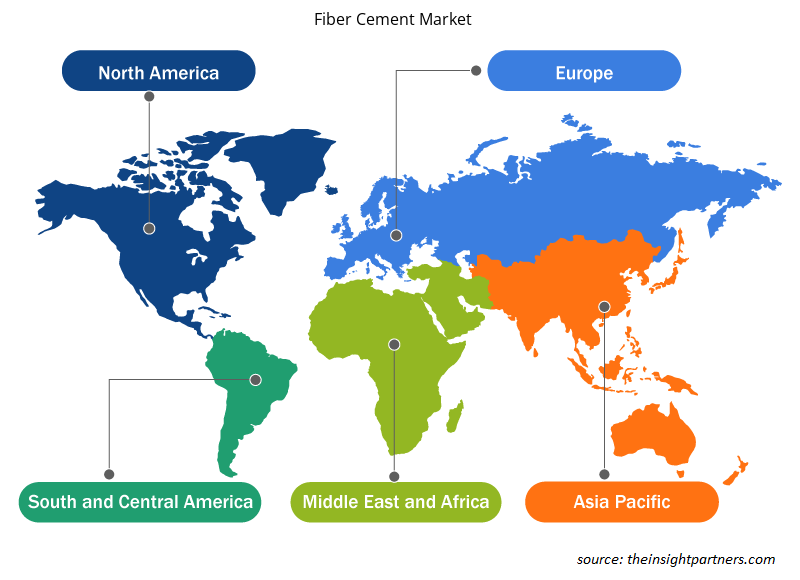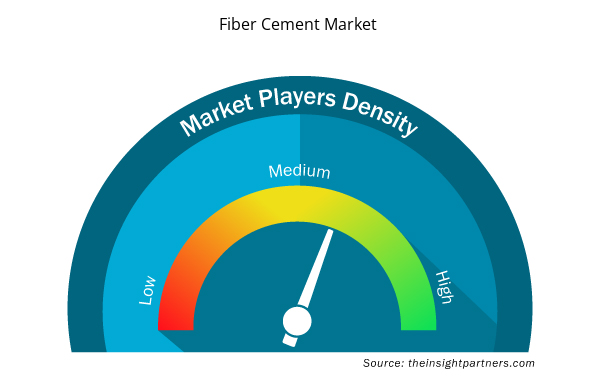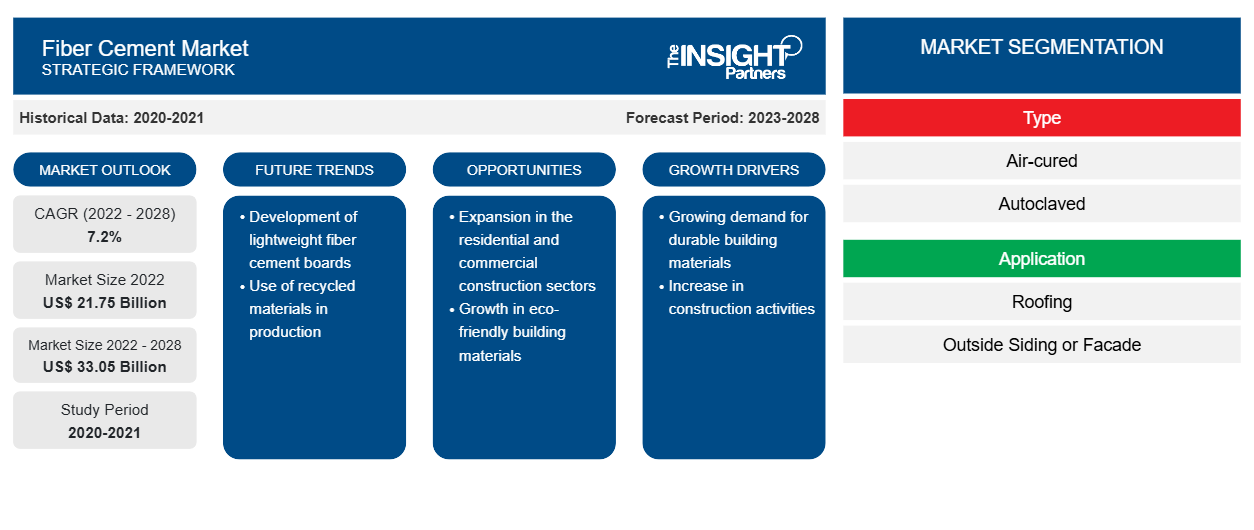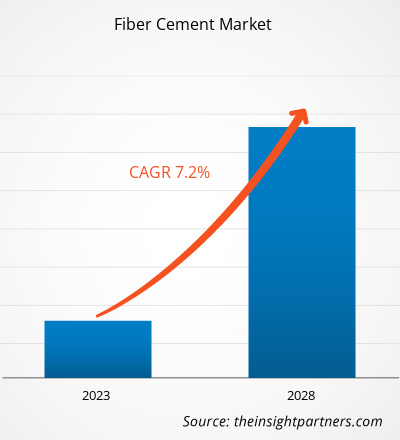[研究报告] 纤维水泥市场规模预计将从 2022 年的 217.4845 亿美元增长到 2028 年的 330.5223 亿美元;预计 2022 年至 2028 年的复合年增长率为 7.2%。
纤维水泥通常用作外墙材料,因为它具有出色的耐用性、耐候性和防火性。此外,纤维水泥还经常用作屋顶材料,因为它能够承受恶劣的天气条件,例如暴雨、冰雹和风。此外,纤维水泥还可用于装饰和面板工作,因为它易于成型,可以涂漆或染色以匹配建筑物的外观。它也经常用于商业建筑,例如医院、学校和办公楼,因为它为这些建筑的外墙提供了一种低维护、耐用的选择。
2022 年,亚太地区占据全球纤维水泥市场的最大收入份额。由于人们越来越意识到纤维水泥的好处,亚太地区对纤维水泥的需求正在增加。由于建筑活动的激增,该地区已成为纤维水泥板利用的主要市场之一。此外,政府的举措和政策(如“印度制造”)鼓励在印度建立不同的制造厂。不断增加的外国直接投资也促进了该地区的经济增长。纤维水泥板在众多住宅和非住宅领域的使用量不断增加,预计未来几年亚太地区对纤维水泥板的需求将增加。在印度,建筑业是仅次于农业的第二大产业,约占该国 GDP 的 11%。建筑业是市场增长的重要贡献者。
定制此报告以满足您的需求
您可以免费定制任何报告,包括本报告的部分内容、国家级分析、Excel 数据包,以及为初创企业和大学提供优惠和折扣
- 获取此报告的关键市场趋势。这个免费样品将包括数据分析,从市场趋势到估计和预测。
COVID-19 疫情对纤维水泥市场的影响
建筑业是纤维水泥需求的主要贡献者。COVID-19 疫情对化学品和材料行业以及纤维水泥市场的增长产生了不利影响。为抗击 SARS-CoV-2 传播而采取的措施对各行业的增长产生了负面影响。由于国家和国际边界突然关闭,包装、消费品、汽车和运输、纺织、建筑和施工等行业受到运营效率和价值链中断的不利影响。在 COVID-19 疫情期间,收入下降和项目交付挑战增加导致该行业在大多数市场萎缩,并对劳动力产生了相应的负面影响。由于许多工厂长期关闭,建筑商经历了进口原材料和场外建筑材料的延误和成本增加。疫情期间,建筑业的受损阻碍了对纤维水泥的需求。
市场洞察
节能建筑需求激增推动纤维水泥市场增长
根据能源部门管理援助计划,全球近三分之一的能源消耗在住宅、公共和商业建筑中,用于空间制冷、供暖、通风、烹饪、冷藏、照明、热水以及操作电气和机械设备。发展中国家的城市现代化和人均 收入的提高推动了全球建筑的能源使用。公共、住宅和商业建筑的高能耗产生了节能的需要。根据国际能源署的数据,到 2035 年,建筑预计将占全球节能潜力的 41%,工业部门和运输部门将分别占 24% 和 21%。在建筑物上涂一层纤维水泥,以减少通过墙壁的热量传递,使室内在冬天更温暖,在夏天更凉爽,这有助于降低能源消耗。根据ASHRAE基础手册,纤维水泥的 R 值为 0.15,优于砖和石头的 R 值。
类型洞察
根据类型,全球纤维水泥市场分为空气固化和高压灭菌。高压灭菌部分在 2022 年占据了更大的市场份额。高压灭菌纤维水泥由水泥、沙子、纤维素纤维和其他添加剂的混合物制成。混合物形成为片材或板材,然后在高压釜中固化,高压釜是一种将热量和蒸汽施加到材料的高压容器。高压灭菌过程会引起化学反应,从而增强材料强度,使其更耐用,更耐水、火和虫害。它通常用于广泛的应用,包括屋顶、墙板、地板和作为 瓷砖的背衬。此外,高压灭菌纤维水泥还以其多功能性和设计灵活性而闻名,因为它可以模仿其他建筑材料的外观,例如木材或石材。它还有多种颜色和纹理可供选择,使其成为住宅和商业建筑项目的热门选择。
James Hardie Industries plc、Etex NV、Swisspearl Group AG、CSR Ltd、NICHIHA Corp、Plycem Construsistemas Costa Rica SA、Compagnie de Saint Gobain SA、Century Plyboards Ltd、Everest Industries Ltd 和 Isam Khairi Kabbani Group 是全球纤维水泥市场中的几家主要参与者。市场参与者专注于提供高质量的产品以满足客户需求。他们还采取了投资研发活动和推出新产品等策略。
报告亮点
- 纤维水泥市场的渐进式行业趋势可帮助参与者制定有效的长期战略
- 发达市场和发展中市场采用的业务增长战略
- 2020 年至 2028 年纤维水泥市场定量分析
- 全球纤维水泥需求量估计
- 波特五力分析说明了行业内买家和供应商的效力
- 了解竞争市场状况的最新发展
- 市场趋势和前景,以及推动和抑制纤维水泥市场增长的因素
- 通过强调支撑商业利益的市场策略来协助决策过程,从而促进市场增长
- 不同节点的纤维水泥市场规模
- 市场的详细概述和细分,以及纤维水泥行业动态
- 各地区纤维水泥市场规模及增长机遇
纤维水泥市场区域洞察
Insight Partners 的分析师已详细解释了预测期内影响纤维水泥市场的区域趋势和因素。本节还讨论了北美、欧洲、亚太地区、中东和非洲以及南美和中美洲的纤维水泥市场细分和地理位置。

- 获取纤维水泥市场的区域特定数据
纤维水泥市场报告范围
| 报告属性 | 细节 |
|---|---|
| 2022 年市场规模 | 217.5亿美元 |
| 2028 年市场规模 | 330.5亿美元 |
| 全球复合年增长率(2022 - 2028) | 7.2% |
| 史料 | 2020-2021 |
| 预测期 | 2023-2028 |
| 涵盖的领域 | 按类型
|
| 覆盖地区和国家 | 北美
|
| 市场领导者和主要公司简介 |
|
市场参与者密度:了解其对商业动态的影响
纤维水泥市场正在快速增长,这得益于最终用户需求的不断增长,而这些需求又源于消费者偏好的不断变化、技术进步以及对产品优势的认识不断提高等因素。随着需求的增加,企业正在扩大其产品范围,进行创新以满足消费者的需求,并利用新兴趋势,从而进一步推动市场增长。
市场参与者密度是指在特定市场或行业内运营的企业或公司的分布情况。它表明在给定市场空间中,相对于其规模或总市场价值,有多少竞争对手(市场参与者)存在。
在纤维水泥市场运营的主要公司有:
- 詹姆斯哈迪工业公司
- 埃泰克斯公司
- Swisspearl 集团
- 中国社会责任有限公司
- 日光化学公司
免责声明:上面列出的公司没有按照任何特定顺序排列。

- 了解纤维水泥市场顶级关键参与者概况
全球纤维水泥市场
根据纤维类型,全球纤维水泥市场根据类型、应用和最终用途进行细分。根据类型,全球纤维水泥市场分为空气固化和高压釜。根据应用,纤维水泥市场分为屋顶、外墙或外墙等。根据最终用途,纤维水泥市场分为住宅和非住宅。
公司简介
- 詹姆斯哈迪工业公司
- 埃泰克斯公司
- Swisspearl 集团
- 中国社会责任有限公司
- 日光化学公司
- 哥斯达黎加 Plycem Construsistemas SA
- 圣戈班公司
- 世纪胶合板有限公司
- 珠穆朗玛工业有限公司
- Isam Khairi 卡巴尼集团
- 历史分析(2 年)、基准年、预测(7 年)及复合年增长率
- PEST 和 SWOT 分析
- 市场规模价值/数量 - 全球、区域、国家
- 行业和竞争格局
- Excel 数据集



Report Coverage
Revenue forecast, Company Analysis, Industry landscape, Growth factors, and Trends

Segment Covered
This text is related
to segments covered.

Regional Scope
North America, Europe, Asia Pacific, Middle East & Africa, South & Central America

Country Scope
This text is related
to country scope.
常见问题
Asia Pacific accounted for the largest share of the global fiber cement market. Asia Pacific is one of the most significant regions for the fiber cement market owing to surging demand for energy-efficient buildings.
Durability is one of the most desirable qualities of fiber cement. Fiber cement siding, boards, and panels typically outlast vinyl siding and other alternative products in lifespan. Within 10 to 15 years, vinyl siding can show signs of aging, whereas fiber cement siding can last up to 30 to 50 years or more. Further, in cement production, carbon dioxide is a byproduct. However, manufacturing vinyl siding containing polyvinyl chloride (PVC) produces more carbon dioxide than cement production. Hence, fiber cement siding is a greener alternative to vinyl siding. Fiber cement products do not require frequent repainting as it holds paint well. Also, they do not dent unlike steel siding. Fiber cement products stand stronger in moisture and leaks than gypsum boards. These products possess excellent moisture-absorbing and drying properties, making them resistant to weather changes.
Based on type, autoclaved segment held the largest revenue share owing to the its durability and resistance to water, fire, and pests.
Based on the application, roofing segment is projected to grow at the fastest CAGR over the forecast period. Fiber cement roofing sheets and tiles are popular for their durability, resistance to weathering, and low maintenance requirements. They are also available in a variety of colors and styles to suit multiple architectural requirements and design preferences.
According to the World Bank, across the world, a large proportion of the population lives in cities. In 2011, 52.0% lived in urban areas. Over the last ten years, owing to urbanization in developing economies in Asia and Oceania, the urbanization rate increased from 43.3% in 2011 to 50.0% in 2021. Africa has seen a 4.6% increase in the same period. Governments of various countries across the world focus on supporting and increasing construction activities. Saudi Arabia launched its Saudi Vision 2030 to diversify its economy, modernize its administration, and introduce bold reforms in many sectors. The country is targeting to increase the contribution of its construction sector to the overall GDP. Due to its Saudi Vision 2030, the country's construction market reports significant growth in residential and nonresidential segments and offers lucrative potential to fiber cement.
The major players operating in the global fiber cement market are James Hardie Industries plc, Etex NV, Swisspearl Group AG, CSR Ltd, NICHIHA Corp, Plycem Construsistemas Costa Rica SA, Compagnie de Saint Gobain SA, Century Plyboards Ltd, Everest Industries Ltd, and Isam Khairi Kabbani Group.
Trends and growth analysis reports related to Chemicals and Materials : READ MORE..
The List of Companies - Fiber Cement Market
- James Hardie Industries plc
- Etex NV
- Swisspearl Group AG
- CSR Ltd
- NICHIHA Corp
- Plycem Construsistemas Costa Rica SA
- Compagnie de Saint Gobain SA
- Century Plyboards Ltd
- Everest Industries Ltd
- Isam Khairi Kabbani Group
The Insight Partners performs research in 4 major stages: Data Collection & Secondary Research, Primary Research, Data Analysis and Data Triangulation & Final Review.
- Data Collection and Secondary Research:
As a market research and consulting firm operating from a decade, we have published and advised several client across the globe. First step for any study will start with an assessment of currently available data and insights from existing reports. Further, historical and current market information is collected from Investor Presentations, Annual Reports, SEC Filings, etc., and other information related to company’s performance and market positioning are gathered from Paid Databases (Factiva, Hoovers, and Reuters) and various other publications available in public domain.
Several associations trade associates, technical forums, institutes, societies and organization are accessed to gain technical as well as market related insights through their publications such as research papers, blogs and press releases related to the studies are referred to get cues about the market. Further, white papers, journals, magazines, and other news articles published in last 3 years are scrutinized and analyzed to understand the current market trends.
- Primary Research:
The primarily interview analysis comprise of data obtained from industry participants interview and answers to survey questions gathered by in-house primary team.
For primary research, interviews are conducted with industry experts/CEOs/Marketing Managers/VPs/Subject Matter Experts from both demand and supply side to get a 360-degree view of the market. The primary team conducts several interviews based on the complexity of the markets to understand the various market trends and dynamics which makes research more credible and precise.
A typical research interview fulfils the following functions:
- Provides first-hand information on the market size, market trends, growth trends, competitive landscape, and outlook
- Validates and strengthens in-house secondary research findings
- Develops the analysis team’s expertise and market understanding
Primary research involves email interactions and telephone interviews for each market, category, segment, and sub-segment across geographies. The participants who typically take part in such a process include, but are not limited to:
- Industry participants: VPs, business development managers, market intelligence managers and national sales managers
- Outside experts: Valuation experts, research analysts and key opinion leaders specializing in the electronics and semiconductor industry.
Below is the breakup of our primary respondents by company, designation, and region:

Once we receive the confirmation from primary research sources or primary respondents, we finalize the base year market estimation and forecast the data as per the macroeconomic and microeconomic factors assessed during data collection.
- Data Analysis:
Once data is validated through both secondary as well as primary respondents, we finalize the market estimations by hypothesis formulation and factor analysis at regional and country level.
- Macro-Economic Factor Analysis:
We analyse macroeconomic indicators such the gross domestic product (GDP), increase in the demand for goods and services across industries, technological advancement, regional economic growth, governmental policies, the influence of COVID-19, PEST analysis, and other aspects. This analysis aids in setting benchmarks for various nations/regions and approximating market splits. Additionally, the general trend of the aforementioned components aid in determining the market's development possibilities.
- Country Level Data:
Various factors that are especially aligned to the country are taken into account to determine the market size for a certain area and country, including the presence of vendors, such as headquarters and offices, the country's GDP, demand patterns, and industry growth. To comprehend the market dynamics for the nation, a number of growth variables, inhibitors, application areas, and current market trends are researched. The aforementioned elements aid in determining the country's overall market's growth potential.
- Company Profile:
The “Table of Contents” is formulated by listing and analyzing more than 25 - 30 companies operating in the market ecosystem across geographies. However, we profile only 10 companies as a standard practice in our syndicate reports. These 10 companies comprise leading, emerging, and regional players. Nonetheless, our analysis is not restricted to the 10 listed companies, we also analyze other companies present in the market to develop a holistic view and understand the prevailing trends. The “Company Profiles” section in the report covers key facts, business description, products & services, financial information, SWOT analysis, and key developments. The financial information presented is extracted from the annual reports and official documents of the publicly listed companies. Upon collecting the information for the sections of respective companies, we verify them via various primary sources and then compile the data in respective company profiles. The company level information helps us in deriving the base number as well as in forecasting the market size.
- Developing Base Number:
Aggregation of sales statistics (2020-2022) and macro-economic factor, and other secondary and primary research insights are utilized to arrive at base number and related market shares for 2022. The data gaps are identified in this step and relevant market data is analyzed, collected from paid primary interviews or databases. On finalizing the base year market size, forecasts are developed on the basis of macro-economic, industry and market growth factors and company level analysis.
- Data Triangulation and Final Review:
The market findings and base year market size calculations are validated from supply as well as demand side. Demand side validations are based on macro-economic factor analysis and benchmarks for respective regions and countries. In case of supply side validations, revenues of major companies are estimated (in case not available) based on industry benchmark, approximate number of employees, product portfolio, and primary interviews revenues are gathered. Further revenue from target product/service segment is assessed to avoid overshooting of market statistics. In case of heavy deviations between supply and demand side values, all thes steps are repeated to achieve synchronization.
We follow an iterative model, wherein we share our research findings with Subject Matter Experts (SME’s) and Key Opinion Leaders (KOLs) until consensus view of the market is not formulated – this model negates any drastic deviation in the opinions of experts. Only validated and universally acceptable research findings are quoted in our reports.
We have important check points that we use to validate our research findings – which we call – data triangulation, where we validate the information, we generate from secondary sources with primary interviews and then we re-validate with our internal data bases and Subject matter experts. This comprehensive model enables us to deliver high quality, reliable data in shortest possible time.


 获取此报告的免费样本
获取此报告的免费样本